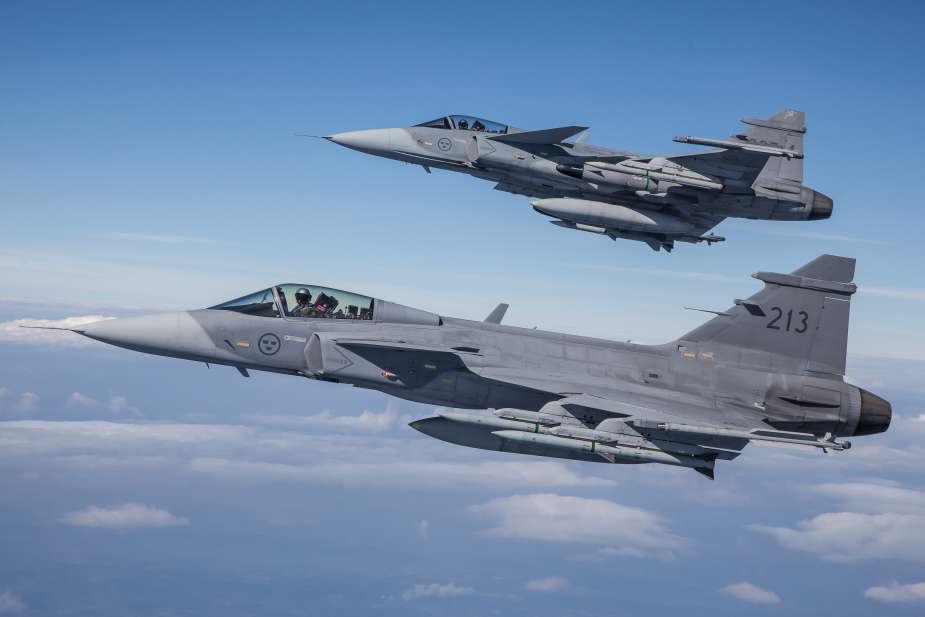Breaking news
Analysis: Exploring SAAB Gripen Fighter Jet's Combat Capabilities to Enhance Ukraine's Air Force.
According to information reported by the Army Recognition editorial team on March 29, 2024, Sweden has expressed openness to potentially supplying its state-of-the-art Gripen fighter jets to Ukraine. This move could mark a pivotal shift in the balance of air power in the region. In light of this announcement, we delve into an in-depth analysis of the Gripen's advanced combat capabilities.
Follow Army Recognition on Google News at this link

The Saab JAS 39 Gripen is a lightweight, single-engine, supersonic multirole fighter aircraft developed by Sweden's Saab AB aerospace and defense company. (Picture source SAAB)
By comparing these capabilities against the Soviet-era aircraft currently in service with the Ukrainian Air Force—namely, the Sukhoi Su-24, Su-25, Su-27, and MiG-29—this article aims to highlight the strategic advantages and enhanced operational flexibility the Gripen could offer to Ukraine's aerial defense forces.
The SAAB Gripen is a testament to modern aviation design, offering a versatile platform capable of performing an array of combat and reconnaissance missions. Unlike Ukraine's current fleet, which includes aircraft specialized in either air-to-air combat (Su-27, MiG-29) or ground attack roles (Su-24, Su-25), the Gripen excels in both arenas. This multi-role capability ensures that the Ukrainian air force can execute diverse missions with a single type of aircraft, simplifying logistics, maintenance, and pilot training.
One of the Gripen's standout features is its state-of-the-art avionics suite. Equipped with AESA (Active Electronically Scanned Array) radar, the Gripen offers superior situational awareness, allowing it to detect, track, and engage multiple targets at greater distances and with higher precision than the radars on Ukraine's current aircraft. This technological edge could significantly enhance the Ukrainian air force's operational effectiveness, providing a crucial advantage in both offensive and defensive operations.
Coupled with its avionics, the Gripen's performance characteristics, such as its high thrust-to-weight ratio and delta canard design, afford it exceptional maneuverability. This agility enables the Gripen to excel in dogfighting scenarios and evade incoming threats more effectively than many of its contemporaries.

The Gripen is a versatile multi-role fighter jet capable of executing various missions with a broad arsenal of armaments. (Picture source SAAB)
The Gripen's multi-role capability is significantly augmented by its wide array of armament options, allowing it to carry a mix of weapons tailored to the mission's requirements. This flexibility ensures that the Gripen can engage various target types, from enemy aircraft and ground forces to naval units and infrastructure.
Air-to-Air Missiles: For air superiority missions, the Gripen can be equipped with a variety of beyond-visual-range (BVR) and short-range air-to-air missiles (AAMs). This includes the AIM-120 AMRAAM for long-range engagements and the IRIS-T or AIM-9 Sidewinder for closer encounters. These weapons enable the Gripen to engage enemy aircraft from a safe distance or defend itself in close-quarters combat.
Air-to-Ground Munitions: The Gripen's air-to-ground capabilities are supported by an extensive selection of munitions. Precision-guided bombs such as the GBU-12 Paveway II and standoff weapons like the AGM-65 Maverick allow the Gripen to strike ground targets with high accuracy, minimizing collateral damage. For missions requiring area effects, it can also carry unguided bombs and cluster munitions.
Anti-Ship and Standoff Weapons: The Gripen can be outfitted with anti-ship missiles, such as the RBS-15, designed to engage naval vessels from considerable distances. Furthermore, standoff weapons like the Taurus KEPD 350 or the AGM-158 JASSM enable the Gripen to conduct deep-strike missions against high-value targets well-protected by enemy air defenses.
Reconnaissance and Electronic Warfare: Besides kinetic armaments, the Gripen can carry pods for electronic warfare and reconnaissance missions. These pods enhance its capability to gather intelligence and conduct electronic attacks, disrupting enemy communications and radar systems.
Operating within a constrained budget, the cost-effectiveness of the Gripen is a compelling advantage for Ukraine. The aircraft boasts lower operational and maintenance costs compared to both its Western counterparts and the aging Soviet-era jets in Ukraine's arsenal. Furthermore, the Gripen's design emphasizes ease of maintenance and the ability to operate from short and improvised runways, offering high operational flexibility in conflict zones.
As Ukraine moves closer to NATO standards, the Gripen's compatibility with Western technology and armaments stands out. Unlike the Soviet-era aircraft, which require substantial modifications to integrate NATO-compatible weapons and communication systems, the Gripen is designed from the ground up to operate within NATO's framework. This interoperability would facilitate smoother collaboration with allied forces and streamline Ukraine's transition to a more Western-oriented defense posture.
The Gripen's multi-role combat capabilities, underpinned by its advanced avionics, superior performance, and versatile armament options, position it as a highly effective platform for achieving air superiority and conducting precise strike missions. Its ability to adapt to various combat roles within a single sortie provides operational flexibility, making the Gripen an invaluable asset for modern air forces seeking to maintain dominance in the air and effectively support ground and naval operations.
Defense News March 2024























